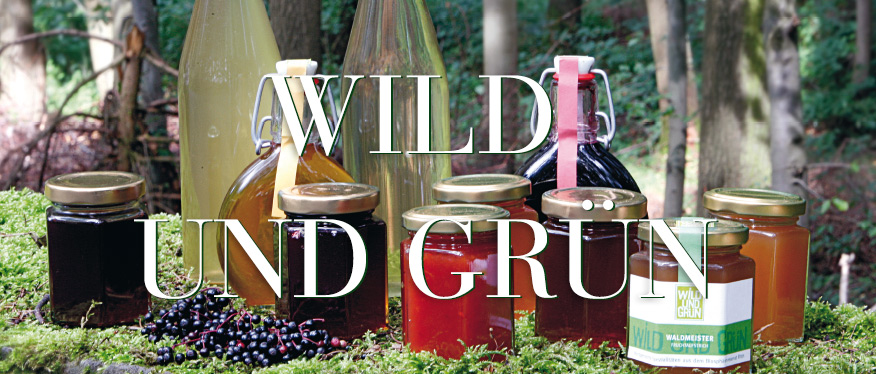Ulrike and Jens Lilienbecker founded Wild und Grün – the label for handmade delicacies from the German Rhön Biosphere Reserve
It is quiet. The view from the old pheasantry extends over rolling hills, forest and open spaces. A land of open distances. The Bavarians came up with this title because the Rhön Biosphere Reserve has spanned three federal states since 1991. With 70,000 hectares, the Bavarians are once again the largest, followed by Hesse and Thuringia. There, almost on the old border strip, the Fasanerie hunting lodge towers above the landscape in the new federal state. From the lawn terrace, you can still see a watchtower of the defunct GDR in the meadow green. “If you want to climb it, you can borrow the key from us,” explains Ulrike Lilienbecker. Together with her husband Jens, she leased the classicist-baroque estate near the village of Hermannsfeld in 2003, which Duke Georg I of Saxe-Meiningen had built around 1790.

Some people know Meiningen because it is home to a theater steeped in history in the middle of the province. But the area around it is more of a German no-man’s land, even though it suddenly moved back to the center after the fall of the Wall. Discover a pristine cultural landscape with an area of 180,000 hectares that is home to only around 130,000 people – also a luxury for nature and its products. “Biosphere reserves have been selected by UNESCO since 1970 and are subject to fewer conditions than nature reserves,” explains Ulrike Lilienbecker. She studied geography and met Jens, a communication scientist, in Frankfurt when she was giving seminars at the university there. “Economic development, location promotion”, the couple later set up their own company in Erfurt and took on projects from the state, which wanted to bring work to the former border zone after reunification. “The proximity to the border helped us to ensure that the villages were able to retain their old structures, as they were located in the security zone,” explains Jens Lilienbecker. And indeed, as you approach the former hunting lodge, you seem to be immersed in the world of the post-war period. The images from “Heimat”, the epic film by Edgar Reitz, keep coming to mind – many exciting hours about a small village in the Hunsrück and the fate of its inhabitants.

Rosehips in the hand. The easiest way to cut them from the thorny branches is with a pair of scissors, and they will later enrich the repertoire of game and greens with their particularly full flavor. The fruits of the rose had almost been forgotten as a foodstuff, even though they contain a particularly high amount of vitamin C.
But we are in the Rhön, a biosphere reserve, in 2007. The idea of sustainably protecting a cultural landscape and thus guaranteeing its inhabitants an economic future could not have been better realized in the almost too perfectly restored hunting lodge. The Russians were here after the war – the officer’s crooked wooden house on the site still tells the story. Later, the SED state set up a home; and shortly before the end of the GDR, the inhabitants of Hermannsfeld prevented their castle from being demolished. “They did the work themselves to maintain the building,” explains Jens Lilienbecker, “but after reunification, there was soon no user. The pheasantry was empty and we discovered it during our work.” Their office was tasked with developing new perspectives for 48 Thuringian Rhön communities, and in the end they found their own future. “I’ve loved cooking since I was a little girl,” explains Ulrike, “and we are committed supporters of the slow food idea. So we took the plunge and opened a restaurant in the castle.” Philosophy: Only products from sustainable farmers in the region should appear on the menu and the aim was to create permanent jobs to prevent more people from moving away. Later, a genuine private label was also added. Wild and green: a label for culinary Rhön products. “You can buy our cake in a jar at Dallmayr in Munich,” says Ulrike with pride. “When they send us a large order, it’s a big deal for us.” The professional kitchen then bakes in traditional preserving jars, for example sour cherries with marzipan or spruce tips with chocolate. A network of women helps and contributes the necessary know-how to turn the fruits of the Rhön into something decent. This then leads to the author’s product, so to speak. The customer learns that Doris Voderlind gets up at five in the morning to collect blueberries in the forest for her fruit spread. Bärbel Wachter, on the other hand, collects wild raspberries, which are cooked with a little sugar. A jar with hand-picked contents costs 4.80 euros and can of course also be ordered online. Elder and lime blossom, sloes – the wild tradition is the basis of the repertoire: the forest and culture come together in the cuisine of the biosphere reserve. “The people here used to be poor, so they made their honey from dandelion flowers,” explains the lady of the castle. “We asked around and you can try this recipe today as a dandelion spread.” The yellow flowers provide unexpected aromas, they stand for poverty and beauty. The Lilienbeckers want to combine this traditional beauty with a contemporary lifestyle, and that requires total commitment. The hunting lodge, restored as a monument with all-German funds, helps them. Seminars are held on the upper floor in the magnificent hall with its painted ceiling. The work of the Hermannsfelder, who did not want to part with the familiar institution, won a prize …


